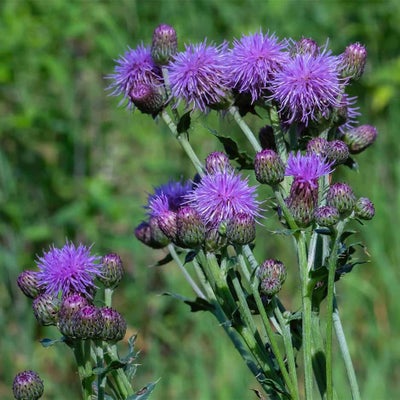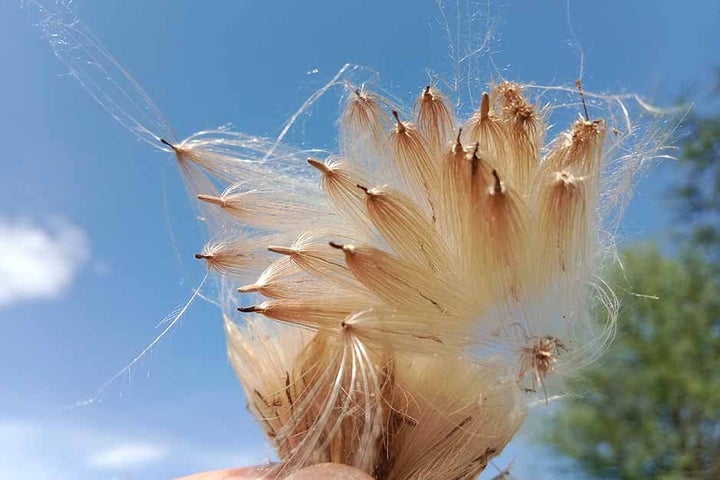
Quick facts
The botanical name for creeping thistle is Cirsium arvense; it is also commonly known as Californian thistle and Canada thistle.
It is a fantastic plant for wildlife, providing food for birds, bees, butterflies, moths and a variety of small invertebrates
Creeping thistle can outcompete border plants and spreads quickly, so is often considered a weed
Controlling creeping thistle can be tricky, requiring patience and persistence
What does creeping thistle look like?
Creeping thistle is a plant that produces clumps of spiny, divided leaves and erect, branching flower stems 30cm-1.2m (1-4ft) tall. The flowers, borne from June to September, are lilac-pink with many florets sitting atop a cylinder of purplish bracts. It is usually dioecious, with male and female flowers on separate plants. Flowers are followed from late summer by masses of tiny seed, each attached to a clump of fine hairs for wind dispersal. En masse, these hairs create fluffy thistledown.
Creeping thistle produces a after , followed by spreading roots and . Its deep roots are brittle and produce shoots from along their length.

There are several other thistles that could be confused with creeping thistle. They vary in height and spininess, but all have similar looking flowers. RHS members can use the Gardening Advice service for help with identification.
Is creeping thistle a weed?
Creeping thistle is a UK , commonly found throughout the country on grassland, waste ground, roadside verges and field margins. It is a valuable plant for wildlife, providing food for a range of invertebrates, including caterpillars of the painted lady butterfly. Its flowers provide nectar for moths and butterflies, including the small tortoiseshell, white letter hairstreak, peacock and meadow brown, and nectar and pollen for bees. Its seeds are also an important food source for a variety of farmland and garden birds, including goldfinches, greenfinches, siskins and lesser redpolls, many of which also use the thistledown for nest building.

Despite its many benefits, creeping thistle is listed in the Weeds Act 1959, which exists to control the spread of plants considered problematic on agricultural land. Under the legislation, control measures to prevent creeping thistle from spreading need to be taken if an order to do so is served to you by a government official.
Although its inclusion in the Weeds Act 1959 reflects how successful it is at spreading, creeping thistle is much easier to manage in a garden situation compared to large areas of agricultural land. It is therefore perfectly acceptable, and indeed very beneficial, to allow creeping thistle to grow in some parts of your garden. However, where it competes with other plants for moisture, nutrients, space and light, you might choose to remove it or limit its spread.
Did you know?
Another native thistle, the spear thistle (Cirsium vulgare), is included in the Weeds Act 1959 legislation. Similar looking to creeping thistle, though biennial with spinier stems, it is also widespread and can become a nuisance in gardens.
Frequently asked questions about controlling creeping thistle
Here are our answers to your most common questions about dealing with creeping thistle:
How invasive is creeping thistle?
As its common name suggests, creeping thistle spreads to form large colonies. Its roots and are brittle and regenerate easily if broken up by digging.
As most plants are dioecious, and large clumps tend to be of a single plant, the flowers of creeping thistle are rarely pollinated, and thistledown is often devoid of seed or contains unviable seed. However, when they are pollinated, plants produce an abundance of seed, estimated to be around two hundred per flowerhead, several hundred per stem and thousands per plant. Being wind-pollinated, they can travel some distance from the parent plant and are able to grow, flower and set seed themselves within a year.

Did you know?
Creeping thistle is an invasive species and serious agricultural weed in many countries, including the US, Canada and New Zealand. Here they have introduced two invertebrates, the large thistle weevil (Cleonis pigra) and the thistle tortoise beetle (Cassida rubiginosa), both common in UK gardens, as biological controls.
Do I need to get rid of creeping thistle?
In the unlikely event that you are served with an order under the Weeds Act 1959 to control creeping thistle on your land, then you must comply with this. However, in most gardens it is not necessary to completely eradicate it. Allowing some to grow in a meadow, wildlife corner or less-cultivated area is a great way to boost the of your garden and gives you the chance to enjoy its attractive flowers.
It is, however, a good idea to control creeping thistle to stop it spreading to parts of your garden where it might smother and outcompete other plants.
What is the easiest way to kill creeping thistle?
If you have creeping thistle growing where it is not wanted, there are several ways to control it:
- – remove faded flowers in summer before they run to seed.
- Hoe off – do this promptly, within the first few weeks of them appearing, before roots produce which they can regenerate from. Hoe on a warm, dry or windy day, so exposed roots dry out quickly.
- Dig or fork out plants – ideally do this when plants are still young and haven’t had time to develop an extensive root system or set seed. As well as removing the main clump of growth, it is important to carefully sift through the adjacent soil to remove as many roots as possible. Remove regrowth promptly, before it becomes established.
- Pull off top growth regularly – this is a good option for controlling awkwardly positioned plants and has the benefit of not disturbing the soil. Wearing thick gloves, simply pull off all above-ground growth as it appears through spring and summer. This weakens the plant, by preventing photosynthesis, and will eventually kill it. Pulling is better than cutting off top growth, as regrowth has to come from root buds, which expends more energy.
- Smother seedlings – thistle seedlings are sensitive to competition for light so apply a mulch of organic matter, around 10cm (4in) thick, to your soil in early spring to smother emerging seedlings. Alternatively, fill gaps in borders with ground cover plants.
- Smother – cover soil with a layer of compostable material, such as cardboard, and then a layer about 20cm (8in) thick of organic matter, such as or wood chips. Alternatively, use a heavy grade matting. This will block light and prevent growth, causing the root system to die. Keep soil covered for a few years, topping up the mulch layer if necessary, to ensure this method is effective.
- Avoid disturbing the soil – creeping thistle easily regenerates from root fragments, so avoid routine digging or in parts of the garden where it grows.
Top Tip
Don’t add the seed or roots of creeping thistle to your home compost bin, as it may not reach high enough temperatures to kill them. Instead, put them in your council green waste recycling bin or take them to your local recycling site.
Should I use a weedkiller?
No – as non-chemical control methods are effective, even if time-consuming, there is no need to use a weedkiller.
The RHS does not support the use of weedkillers and recommends that alternative control methods are used. However, we do note that when gardeners struggle to control plants with cultural methods, regulated weedkillers/pesticides for home gardeners are available for use legally. Garden centres and large retailers selling weedkillers have trained staff who can advise on suitable products for your needs.














